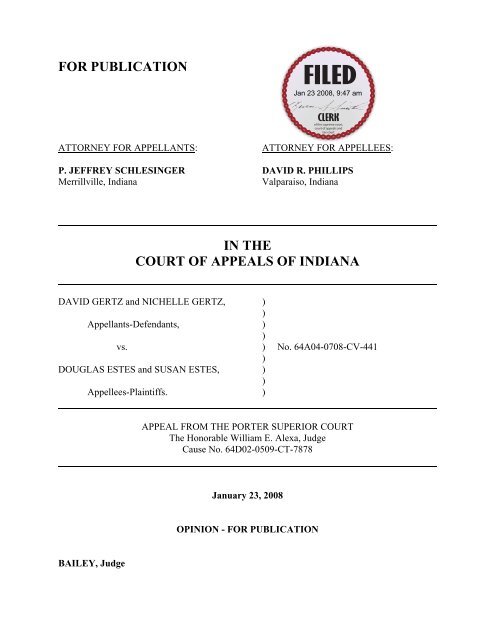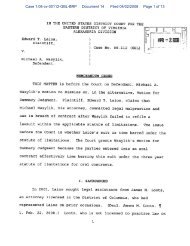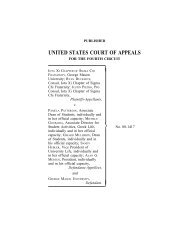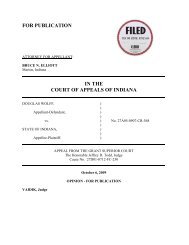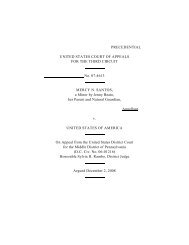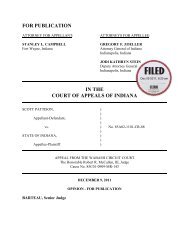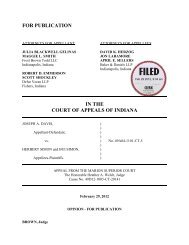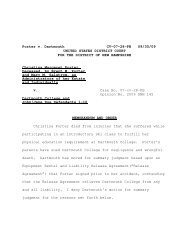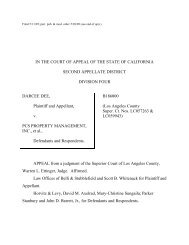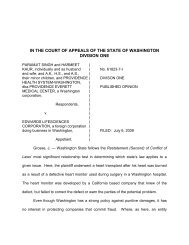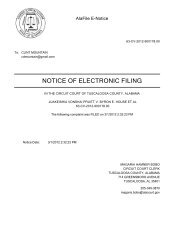David and Nichelle Gertz v. Douglas and Susan ... - State of Indiana
David and Nichelle Gertz v. Douglas and Susan ... - State of Indiana
David and Nichelle Gertz v. Douglas and Susan ... - State of Indiana
Create successful ePaper yourself
Turn your PDF publications into a flip-book with our unique Google optimized e-Paper software.
FOR PUBLICATION<br />
ATTORNEY FOR APPELLANTS: ATTORNEY FOR APPELLEES:<br />
P. JEFFREY SCHLESINGER DAVID R. PHILLIPS<br />
Merrillville, <strong>Indiana</strong> Valparaiso, <strong>Indiana</strong><br />
IN THE<br />
COURT OF APPEALS OF INDIANA<br />
DAVID GERTZ <strong>and</strong> NICHELLE GERTZ, )<br />
)<br />
Appellants-Defendants, )<br />
)<br />
vs. ) No. 64A04-0708-CV-441<br />
)<br />
DOUGLAS ESTES <strong>and</strong> SUSAN ESTES, )<br />
)<br />
Appellees-Plaintiffs. )<br />
BAILEY, Judge<br />
APPEAL FROM THE PORTER SUPERIOR COURT<br />
The Honorable William E. Alexa, Judge<br />
Cause No. 64D02-0509-CT-7878<br />
January 23, 2008<br />
OPINION - FOR PUBLICATION
Case Summary<br />
Appellants-Defendants <strong>David</strong> <strong>and</strong> <strong>Nichelle</strong> <strong>Gertz</strong> (“<strong>David</strong> <strong>and</strong> <strong>Nichelle</strong>”) appeal the<br />
trial court’s order that they remove their fence. We affirm.<br />
follows:<br />
Issues<br />
<strong>David</strong> <strong>and</strong> <strong>Nichelle</strong> raise two issues on appeal, which we re-order <strong>and</strong> re-state as<br />
I. Whether the trial court erred in applying the “spite fence” statute<br />
because <strong>David</strong> <strong>and</strong> <strong>Nichelle</strong> had obtained a local permit for the fence;<br />
<strong>and</strong><br />
II. Whether the trial court clearly erred in making its findings.<br />
Facts <strong>and</strong> Procedural History<br />
Appellees-Plaintiffs <strong>Douglas</strong> <strong>and</strong> <strong>Susan</strong> Estes (“<strong>Douglas</strong> <strong>and</strong> <strong>Susan</strong>”) resided in<br />
Hebron, with their two daughters <strong>and</strong> one son. <strong>David</strong> <strong>and</strong> <strong>Nichelle</strong> bought a neighboring<br />
home in 2003. At some point, <strong>David</strong> <strong>and</strong> <strong>Nichelle</strong> equipped their home with a public address<br />
system <strong>and</strong> installed four surveillance cameras on their barn. In 2004, the two families<br />
disputed the location <strong>of</strong> the property line. While both families had surveys performed <strong>and</strong><br />
thereby resolved the boundary dispute, relations between them deteriorated significantly.<br />
After a series <strong>of</strong> unpleasant events, <strong>David</strong> <strong>and</strong> <strong>Nichelle</strong> received a permit for <strong>and</strong> erected on<br />
their property an eight-foot wooden fence, 1 running parallel to <strong>and</strong> eight inches away from<br />
the property line. <strong>David</strong> estimated the cost <strong>of</strong> building the fence to be $16,000. All along the<br />
three supporting horizontal slats, nail points protruded from the side <strong>of</strong> the fence facing<br />
1 The permit application indicated that the fence would be seven feet tall, not eight feet.<br />
2
<strong>Douglas</strong> <strong>and</strong> <strong>Susan</strong>’s property. The nails extended between a quarter- <strong>and</strong> a half-inch from<br />
the fence.<br />
On September 13, 2005, <strong>Douglas</strong> <strong>and</strong> <strong>Susan</strong> filed a complaint, alleging that the fence<br />
violated the <strong>Indiana</strong> “spite fence” statute. 2 Appendix at 19. A bench trial was conducted in<br />
June <strong>of</strong> 2006. On April 24, 2007, the trial court made findings <strong>and</strong> ordered <strong>David</strong> <strong>and</strong><br />
<strong>Nichelle</strong> to remove the fence, the public address system, <strong>and</strong> the surveillance cameras within<br />
thirty days. The trial court also ordered <strong>David</strong> <strong>and</strong> <strong>Nichelle</strong> to pay <strong>Douglas</strong> <strong>and</strong> <strong>Susan</strong> for<br />
damages amounting to $2500. Finally, the trial court entered protective orders prohibiting<br />
each family from contacting, harassing, or annoying the other family.<br />
<strong>David</strong> <strong>and</strong> <strong>Nichelle</strong> now appeal, seeking to maintain their fence. 3<br />
Discussion <strong>and</strong> Decision<br />
I. Spite Fence Statute<br />
<strong>David</strong> <strong>and</strong> <strong>Nichelle</strong> argue that the statute is inapplicable because they received a local<br />
permit for the fence. Having a local permit, however, is irrelevant to application <strong>of</strong> the<br />
statute.<br />
<strong>Indiana</strong> Code Section 32-26-10-1, titled “Description <strong>of</strong> spite fence,” defines as a<br />
nuisance “a fence unnecessarily exceeding six (6) feet in height, maliciously erected . . . for<br />
the purpose <strong>of</strong> annoying the owners or occupants <strong>of</strong> adjoining property.” An injured<br />
2 Ind. Code §§ 32-26-10-1 <strong>and</strong> -2.<br />
3 <strong>David</strong> <strong>and</strong> <strong>Nichelle</strong> do not challenge the remainder <strong>of</strong> the trial court’s order, including removal <strong>of</strong> the public<br />
address system <strong>and</strong> the surveillance cameras, the damages, <strong>and</strong> the reciprocal protective orders. Accordingly,<br />
we confine our review to the trial court’s order that they remove their fence.<br />
3
l<strong>and</strong>owner may bring a civil action for damages <strong>and</strong> abatement <strong>of</strong> the nuisance. Ind. Code §<br />
32-26-10-2. These statutes “are in derogation <strong>of</strong> the common law, <strong>and</strong> must therefore be<br />
strictly construed.” Wernke v. Halas, 600 N.E.2d 117, 121 (Ind. Ct. App. 1992).<br />
“[M]unicipal ordinances <strong>and</strong> regulations are inferior in status <strong>and</strong> subordinate to the<br />
laws <strong>and</strong> statutes <strong>of</strong> the state.” City <strong>of</strong> <strong>Indiana</strong>polis v. Fields, 506 N.E.2d 1128, 1131 (Ind.<br />
Ct. App. 1987). The statute makes no reference to conformity with local ordinances. Indeed,<br />
in creating a cause <strong>of</strong> action where a fence is “maliciously erected . . . for the purpose <strong>of</strong><br />
annoying the owners or occupants <strong>of</strong> adjoining property,” the legislature made clear its<br />
motivation to address the intent <strong>of</strong> the builder, irrespective <strong>of</strong> other government regulation.<br />
The fact that the Porter County Department <strong>of</strong> Building <strong>and</strong> Planning issued a permit is<br />
inapposite. Moreover, even if the permit were relevant, the fence was not built in accordance<br />
with its terms.<br />
II. Findings <strong>of</strong> Fact<br />
<strong>David</strong> <strong>and</strong> <strong>Nichelle</strong> argue that the trial court clearly erred in making its findings <strong>of</strong><br />
fact. Specifically, they assert that <strong>Douglas</strong> <strong>and</strong> <strong>Susan</strong> failed to establish: (a) that the fence<br />
was unnecessary, <strong>and</strong> (b) that <strong>David</strong> <strong>and</strong> <strong>Nichelle</strong> used their public address system to make<br />
disparaging comments about <strong>Douglas</strong> <strong>and</strong> <strong>Susan</strong>’s family. 4<br />
We review findings <strong>of</strong> fact for clear error. LinkAmerica Corp. v. Albert, 857 N.E.2d<br />
4 As indicated in footnote three, <strong>David</strong> <strong>and</strong> <strong>Nichelle</strong> do not challenge that portion <strong>of</strong> the trial court’s order<br />
requiring them to remove the public address system. We note, however, that <strong>Douglas</strong>’ testimony on this<br />
subject evidences the animosity between the families <strong>and</strong> therefore reflects on the potential motivation <strong>of</strong><br />
<strong>David</strong> <strong>and</strong> <strong>Nichelle</strong> in constructing the fence. <strong>Douglas</strong> testified that “Mrs. <strong>Gertz</strong> is on [the public address<br />
system] on a continuous basis, making lewd comments to my kids, to my girls. They play music over it.<br />
They basically use it on a regular basis to aggravate <strong>and</strong> harass, make lewd comments to the girls.” Transcript<br />
4
961, 965 (Ind. 2006). “‘Findings <strong>of</strong> fact are clearly erroneous when the record lacks any<br />
reasonable inference from the evidence to support them . . . .’ Further, when evaluating<br />
findings <strong>of</strong> fact for clear error, ‘we consider only the evidence favorable to the judgment <strong>and</strong><br />
all reasonable inferences to be drawn therefrom.’” Horseman v. Keller, 841 N.E.2d 164, 169<br />
(Ind. 2006) (quoting Infinity Products, Inc. v. Qu<strong>and</strong>t, 810 N.E.2d 1028, 1031 (Ind. 2004)).<br />
On appeal, the parties acknowledge the “[p]roblems” <strong>and</strong> “deteriorat[ion]” in their<br />
relationship. Appellee’s Brief at 2; Appellant’s Brief at 3. Initially on good terms, one night<br />
<strong>David</strong> <strong>and</strong> <strong>Nichelle</strong> demonstrated to <strong>Douglas</strong> <strong>and</strong> <strong>Susan</strong> that the view from any surveillance<br />
camera, or views from multiple cameras, could be viewed on <strong>David</strong> <strong>and</strong> <strong>Nichelle</strong>’s television.<br />
When the families disputed their property line, their relationship soured. <strong>Douglas</strong> <strong>and</strong> <strong>Susan</strong><br />
added onto their home <strong>and</strong> construction debris blew into <strong>David</strong> <strong>and</strong> <strong>Nichelle</strong>’s yard. <strong>Nichelle</strong><br />
left a voicemail message complaining about three pet cats <strong>Douglas</strong> <strong>and</strong> <strong>Susan</strong> used to control<br />
mice. <strong>David</strong> <strong>and</strong> <strong>Nichelle</strong> collected the cats <strong>and</strong> delivered them to animal control. Also, they<br />
called the sheriff at least eighteen times to report various activities <strong>of</strong> <strong>Douglas</strong> <strong>and</strong> <strong>Susan</strong>. In<br />
March <strong>of</strong> 2005, <strong>David</strong> <strong>and</strong> <strong>Nichelle</strong> installed on their chimney a camera capable <strong>of</strong> rotating<br />
360 degrees <strong>and</strong> magnifying images by twenty-three times.<br />
On February 28, 2005, <strong>David</strong> applied to Porter County to construct a seven-foot fence.<br />
The application, which was approved, indicated that the purpose <strong>of</strong> the fence was residential.<br />
A row <strong>of</strong> trees ran along the property line, on <strong>David</strong> <strong>and</strong> <strong>Nichelle</strong>’s property. Portions<br />
<strong>of</strong> the trees, however, hung over <strong>Douglas</strong> <strong>and</strong> <strong>Susan</strong>’s property. <strong>Douglas</strong> <strong>and</strong> <strong>Susan</strong> sent a<br />
at 45. He gave an example, which we choose not to repeat. Tr. at 46.<br />
5
letter to <strong>David</strong> <strong>and</strong> <strong>Nichelle</strong>, stating that they planned to put up a fence along the property<br />
line <strong>and</strong> that <strong>David</strong> <strong>and</strong> <strong>Nichelle</strong> had a defined time to trim the trees. On June 16, 2005,<br />
<strong>David</strong> <strong>and</strong> <strong>Nichelle</strong>’s attorney, Garry A. Weiss, wrote the following to <strong>Douglas</strong> <strong>and</strong> <strong>Susan</strong>’s<br />
attorney: “Your clients should also be aware that my clients are now keeping the property<br />
under 24 hour surveillance as an additional precautionary measure.” Ex. 5. At some point,<br />
<strong>David</strong> <strong>and</strong> <strong>Nichelle</strong> began building a large fence along the property line. As it was being<br />
erected, the deadline passed for <strong>David</strong> <strong>and</strong> <strong>Nichelle</strong> to trim their trees. <strong>Douglas</strong> then trimmed<br />
the trees.<br />
Ultimately, <strong>David</strong> <strong>and</strong> <strong>Nichelle</strong>’s wooden fence was actually eight feet high <strong>and</strong> 720<br />
feet long. Constructed primarily <strong>of</strong> vertical slats, three horizontal slats provided support.<br />
They ran along the bottom, middle, <strong>and</strong> top <strong>of</strong> the fence. Nails protruded between a quarter-<br />
<strong>and</strong> a half-inch from the fence, placed in roughly two horizontal rows on each horizontal slat.<br />
<strong>Douglas</strong> testified as follows regarding the nails.<br />
A: [The nails] are on the entire length <strong>of</strong> the fence on all three boards that<br />
hold the upright boards up.<br />
Q: So are we talking about thous<strong>and</strong>s <strong>of</strong> protruding nails?<br />
A: Yes.<br />
Transcript at 59. The words “NO CLIMBING” <strong>and</strong> “NO TRESPASSING” were painted in<br />
orange <strong>and</strong> black on the middle horizontal slat. Ex. 10-12. Two cameras were mounted on<br />
top, making a total <strong>of</strong> seven surveillance cameras operated by <strong>David</strong> <strong>and</strong> <strong>Nichelle</strong>.<br />
<strong>David</strong> testified that the fence was necessary to protect eighteen-inch tree seedlings that<br />
he had planted. The fence did not enclose any area. However, <strong>David</strong> testified that he <strong>and</strong> his<br />
6
wife intended to enclose the fence at some point so that they could raise llamas, alpacas, or<br />
sheep.<br />
The trial court found that there was “no justifiable or necessary reason for the fence<br />
installed by [<strong>David</strong> <strong>and</strong> <strong>Nichelle</strong>] to exceed six (6) feet . . . .” App. at 15. Furthermore, it<br />
found that “the fence was maliciously erected <strong>and</strong> now maintained for the purpose <strong>of</strong><br />
annoying [<strong>Douglas</strong> <strong>and</strong> <strong>Susan</strong>].” Id. The evidence <strong>and</strong> the reasonable inferences drawn from<br />
it support the trial court’s findings.<br />
As to <strong>David</strong> <strong>and</strong> <strong>Nichelle</strong>’s specific assertion, there was ample evidence that the fence<br />
was unnecessary <strong>and</strong> that it was not actually intended for agricultural purposes. Their<br />
application for a local permit indicated that the “use” <strong>of</strong> the fence was “residential.” Ex. 14.<br />
The fence did not form an enclosure, making it useless for livestock. The parties’ conduct<br />
<strong>and</strong> the extraordinary nature <strong>of</strong> the fence were adequate to overcome <strong>David</strong>’s assertion that<br />
the eight-foot fence was intended to protect eighteen-inch tree seedlings. The trial court did<br />
not clearly err in making its findings.<br />
Conclusion<br />
The trial court correctly concluded that receiving a local permit was not a defense for<br />
purposes <strong>of</strong> the spite fence statute. Furthermore, evidence supported the trial court’s<br />
findings. 5<br />
Affirmed.<br />
5 In their Reply Brief, <strong>David</strong> <strong>and</strong> <strong>Nichelle</strong> suggest that the trial court’s order somehow violated the Privileges<br />
<strong>and</strong> Immunities Clause <strong>of</strong> Article I, Section 23 <strong>of</strong> the <strong>Indiana</strong> Constitution. The argument is not cogent, not<br />
supported by authority, <strong>and</strong> was not raised in the Appellant’s Brief. Accordingly, it is waived. Ind. Appellate<br />
Rule 46(A)(8)(a), (C); Smith v. <strong>State</strong>, 822 N.E.2d 193, 202-03 (Ind. Ct. App. 2005), trans. denied.<br />
7
NAJAM, J., <strong>and</strong> CRONE, J., concur.<br />
8


